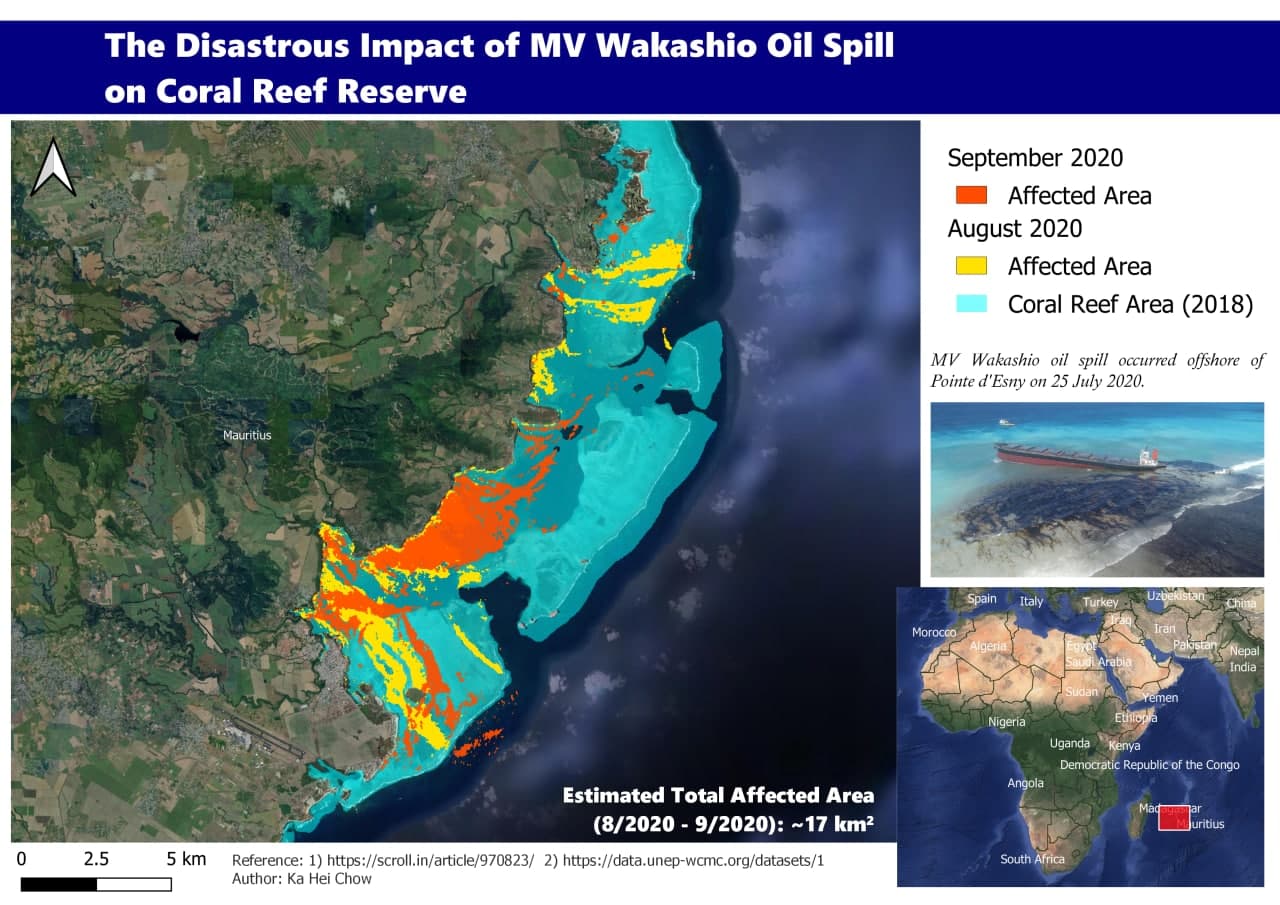The recent marine oil spill that occurred off the coast of Mauritius had widespread repercussions on two sensitive and valuable ecosystems that are already globally declining. We review the incident, along with its fallout and future perspectives in this article.
—
Mauritius is a popular tourist destination because of its white sand beaches, volcanic rocks, beautiful mangrove forests, coral reefs, seagrass and historic buildings. However, on July 25th 2020, a 300 meter long Japanese tanker sailing from China to Brazil named the MV Wakashio ran aground on a barrier reef just southeast of Mauritius.
The Mauritian authorities initiated their national oil contingency plan, and were hopeful to avoid any drastic environmental consequences as there was no leakage in the first few days following the wreck. Unfortunately, several days of rough seas and battering waves ended up opening the hull, allowing fuel oil, diesel and lubricant oil to pour out.
A reported 3000 metric tons (MT) of fuel was pumped out before the ship broke in two, and though many methods of containment were deployed, but not before 1000 MT leaked into the sea. Tens of thousands showed up to help, exposing themselves to the toxic material which caused more than 50 whales and dolphins to wash up dead on the island’s shores.
Compared to others (Amoco Cadiz: ~221,000 MT), the Mauritius oil spill was quite small. And yet, it affects highly sensitive and important types of ecosystems: mangroves, coral reefs and seagrass. All three are some of the most potent carbon sinks on the planet, and are in sharp decline worldwide.

Local communities also depend on these systems, both for sustenance and tourism, which have suffered greatly since the incident (on top of COVID-19 which had already battered the tourism industry). Fishing has been banned in many areas, and over 36km of beach length is off-limits. The success of the cleanup operation has led to a reopening of recreational activities but the mangroves remain heavily contaminated due to their difficulty of access.
The Effects of the Oil Spill
Oil toxicity is mainly due to compounds called polycyclic aromatic hydrocarbons (PAHs), which can bind DNA and protein, don’t dissolve in water, stick together and take ages to disappear. Even in small amounts, they have significant long-term impacts including carcinogenesis.
Mangroves roots are designed to absorb oils, and are therefore highly sensitive to oil spills. The level of poisoning is serious – young plants can die within days, while the older trees might take six or more months. Further, many filter feeders, like corals, crustaceans and mollusks, are very likely to be poisoned, either by being directly coated, or by feeding on oil polluted sediments. This can also transfer to their predators, and so forth all the way up the food chain (us).
As for corals, previous case studies demonstrate that oil spills basically affect all reproductive traits, from gamete recrutement to fecundity, and spawn survival. Because mass spawning occurs around November, we have not yet witnessed the full effects of the spill, but it will likely have significant impact.
Fish generally lack developed cell membranes and detoxification structures. Enough said? Oil spills expose them to malformations, circulatory failure, low appetite, low energy and thus higher vulnerability to predators.
Finally, marine mammals like dolphins, whales and sea turtles often ingest the oil coating the sea surface as they break through to breathe. This leads to a range of complications in the respiratory and gastrointestinal systems that can quickly, or slowly, lead to death.
In Conclusion…
Mauritius is, without a doubt, a natural treasure trove that must be protected for its uniqueness, but also for the role it plays in global environmental health. It’s unfortunate location near a shipping mega route put it at risk that materialized with the MV Wakashio’s wreck. Great cleanup efforts have mitigated the damage, but traces of oil remain that will damage the island’s precious ecosystems for years to come due to the persistence of the toxic compounds.
This article was written by Owen Mulhern. Map and research by Ka Hei Chow.
You might also like: Almost a Quarter of all Freshwater Fish Endangered by Humans










![The Statistics of Biodiversity Loss [2020 WWF Report]](https://u4d2z7k9.rocketcdn.me/wp-content/uploads/2020/12/lprwinkyTHB-544x306.jpg)





